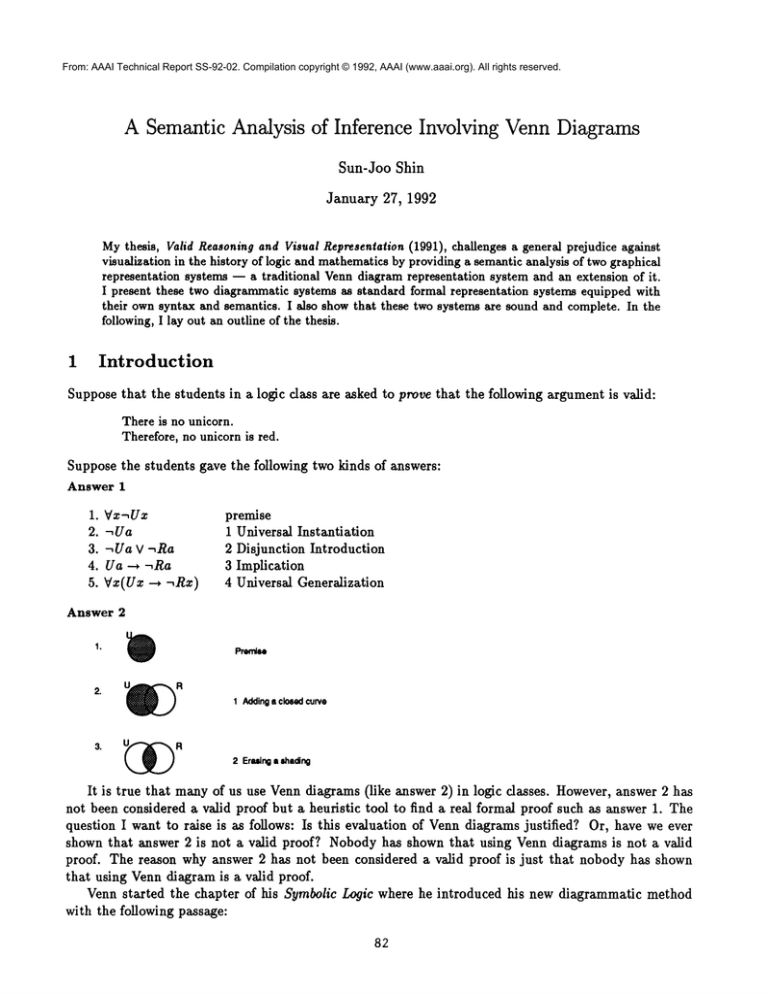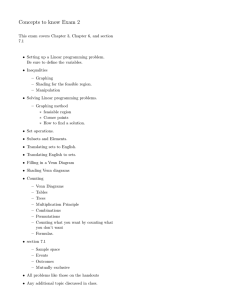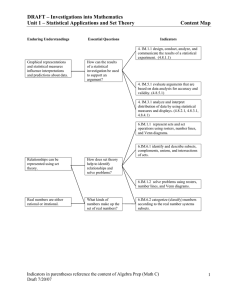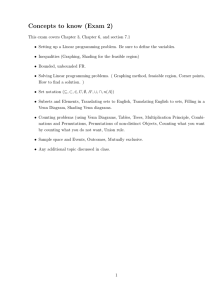
From: AAAI Technical Report SS-92-02. Compilation copyright © 1992, AAAI (www.aaai.org). All rights reserved.
A Semantic Analysis of Inference Involving Venn Diagrams
Sun-Joo Shin
January 27, 1992
Mythesis, Valid Reasoning and Visual Representation (1991), challenges general prejudice ag ainst
visualization in the history of logic and mathematics by providing a semantic analysis of two graphical
representation systems -- a traditional Venn diagram representation system and an extension of it.
I present these two diagrammatic systems as standard formal representation systems equipped with
their own syntax and semantics. I also show that these two systems are sound and complete. In the
following, I lay out an outline of the thesis.
1
Introduction
Suppose that the students in a
logic class are asked to prove that the following argument is valid:
There is no unicorn.
Therefore, no unicorn is red.
Supposethe students gave the following two kinds of answers:
Answer 1
premise
1 UniversalInstantiation
2 Disjunction Introduction
3 Implication
4 Universal Generalization
Answer 2
2°
I Addinga clos~l curve
3.
~jR
2 ErWnga ~adlng
It is true that manyof us use Venndiagrams(like answer2) in logic classes. However,answer2 has
not been considered a valid proof but a heuristic tool to find a real formal proof such as answer1. The
question I want to raise is as follows: Is this evaluation of Venndiagramsjustified? Or, have we ever
shownthat answer 2 is not a valid proof? Nobodyhas shownthat using Venndiagrams is not a valid
proof. The reason whyanswer 2 has not been considered a valid proof is just that nobodyhas shown
that using Venndiagramis a valid proof.
Vennstarted the chapter of his Symbolic Logic where he introduced his newdiagrammatic method
with the following passage:
82
Themajority
of modern
logical
treatises
makeatanyrateoccasional
appeal
to diagrammatic
aid,in
I
order
togivesensible
illustration
oftherelations
ofterms
andpropositions
toeachother.
Afterpresenting
his ownmethod,
he expressed
hisfaithin thediagrammatic
methodin thefollowing
passage:
Of course,we must positivelyinsistthat our diagrammaticschemeand our purely symbolicscheme
shallbe in completecorrespondence
and harmonywith each other .... But symbolicand diagrammatic
systemsare to some extentartificial,
and they oughtto be constructed
as to work in perfectharmony
2together. This merit, so far as it goes, seems at any rate secured on the plan above.
Considering that Venndid not have an appropriate tool, that is, semantics, we understand why Vennhad
to have only this unproven belief that a diagrammatic system, if correct, is at least as good as a correct
symbolic system.
The most interesting point is that even after semantics was introduced in logic, nobody (including
Euler, Venn, Peirce and Prior) has attempted to prove that answer 2 is a valid proof just as answer 1 is,
despite the fact that they have been using Venndiagrams for a long time. Peirce modifies Venn’s system
and introduces the rules of transformation, but he never justifies his rules. At the end of his discussion
of this modified new system, he says that "Enler’s diagrams are the best aids in such cases [non-relative
deductive reasoning], being natural, ... ,3 This remark clearly shows that Peirce has never approved of
using Venndiagrams in a valid proof, since he attributes the role of ’aids’ to this diagrammatic system.
That is, there has been no justification
for the steps taken in answer 2. Why?The answer to this
question is directly related to the following two related prejudices whichreside in the history of logic and
mathematics: (1) a general prejudice for linguistic representation: Only linguistic representation systems
can be used in valid proofs. (2) a general prejudice against visualization: Fallacies often have arisen from
the misuse of diagrams in mathematical proofs. Accordingly, diagrams can be only heuristic tools.
A misconception of valid reasoning is mainly responsible for the first prejudice mentioned above. Valid
reasoning is a process of extracting information, not a process of manipulating symbols. Accordingly,
the essence of valid reasoning lies in the relation amongpieces of information, not in the relation among
syntactic objects by which information is conveyed. If so, there is no legitimate reason to conclude
that only symbolic representation can provide valid proofs. Then, why have we related validity almost
exclusively to linguistic representation? The second prejudice listed above has been one of the main
assumptions which underlie this misconception of validity. Here, we observe an interesting vicious circle:
The worry about the misuse of diagrams has convinced logicians and mathematicians that only symbolic
representation, not diagrams, can be used in valid proofs. In turn, this conviction has prevented us from
making an attempt to give a proper place to visualization in the logical tradition. Again, that there
has been no claim that diagrams can be used in valid proofs has enforced the prejudice for linguistic
representation systems.
I aim to break this circle by claiming that the worry about the misuse of diagrams has been mistakenly
related to the nature of diagrams. If myclaim is correct, the general prejudice for linguistic systems loses
one of the main sources it has heavily relied on. At the same time, myclaim opens the possibility that
diagrams can be used more than just as heuristic tools.
Myclaim is proven through two diagrammatic representation systems -- a traditional Venn diagram
representation system and an extension of it. By giving a semantic analysis of these two visual systems,
I show that we can have valid transformation rules in this diagrammatic system just as we have valid
inference rules in symbolic systems. That is, if we apply only the transformation rules of this system,
fallacies
wouldnotarisein usingVenndiagrams.
1Venn, p. 110.
2Venn, p. 139.
sCharles Haxtshorne and Paul Weiss, p.
317. Peirce calls his modified Venn’s system Euler’s diagrams.
83
I present the Venn diagrams which have been used in logic as a formal system of representation
equipped with its ownsyntax and semantics. (In the following I namethis formal system of Venndiagrams
Venn-I.) I extend Venn-I to what I call Venn-II and also present it as a standard representation system
with its own syntax and semantics. I show that Venn-I and Venn-II, with the rules of transformation
that I specify, are sound and complete. The soundness of these two diagrammatic systems assures us
the following: fallacious inferences we often get in the use of diagrams do not originate in the nature of
diagrams but in a lack of clarity about legitimate manipulation of diagrams.
In the next section, I introduce the way I formalized the syntax and the semantics of Venn-I. In §3,
I mention the new syntactic aspects of Venn-II, that is, a new clause of well-formedness and four new
transformation rules.
2
Venn-I
Peirce adopts Venn’s diagrams, for the representation of sets, replaces Venn’s shading with the symbol
’o’ and adds ’x’ and a line to connect o’s and x’s. However, the connected o’s in Peirce’s system are
so confusing that the system cannot maintain much visual power.4 Peirce’s modification of the Venn
system increases its expressive power, while sacrificing its visual power. I suggest that the Vennsystem
which I call Venn-I and show to be sound and complete should strive for half of Peirce’s modification of
Venn’s system: we want to increase its expressiveness, while maintaining its visuality. Therefore, Venn-I,
of which I am about to establish the syntax and the semantics, consists of the following: (i) Venn’s
representation of sets and the empty set: dosed curve and shading (ii) Peirce’s representation of
non-empty set: ’x’ and the connected x’s (iii) the representation of a background set: rectangle.
2.1
Primitive
objects
Weassume we are given the following sequence of distinct
as follows:
Diagrammatic
Objects
@
diagrammatic objects to which we give names
Name
closedcurve
rectangle
shading
X
®
line
2.2
Well-formed
diagrams
The set of well-formed diagrams, say l), is the smallest set satisfying the following rules:
1. Anyrectangle drawn in the plane is in set/).
2. If D is in the set/), and if ~ r esults b y a dding adosed cu rve in terior to therect angle of D by
the partial-overlapping rule (described below), then ~ is i n s et ~ P.
4Referto the diagrams
in p. 311 or p. 313 of CharlesHartshorne
andPaul Weiss.
84
Partial-overlapping
rule:A newdosedcurveshouldoverlap
everyexistant
minimal
region,
butonly
onceandonlypartof eachminimal
region.
3. If D is in thesetI),andif ~ resultsy bs
hadingome
s ntire
e
egion
r
f oD
, t
hen ~Dis i
n e
st )
7.
~ is in set
4. If D is in theset~),andif l resultsy ba
ddingn aX
toa m
inimal reg
ion of
D, the
n D
~.
~
5. If D is in thesetI),andif resultsy bconnectingxisting
e
’sX y
b lines where
(
ach
e is
X in
different
regions),
thenl is n
i e
st ).
7
2.3
Rules
of transformation
In this subsection, I aim to define what it is to obtain a diagram from some other diagrams. A process of
transformation in this system is analogous to a process of derivation in deductive systems. Weintroduce
sthe following six transformation rules into this system:
RI: The rule of erasure of a diagrammatic object: Wemay copy a wfd omitting one of the following
diagrammatic objects: a dosed curve or a shading or a whole X-sequence.
R2: The rule of erasure of part of an X-sequence: Wemay copy a wfd omitting any subpart of an
X-sequenceonly if that part is in a shaded region.
R3: The rule of spreading X’s: If wfd D has an X-sequence, then we may copy D with ® drawn in
some other region and connected to the existing X-sequence. Since we should get a wfd, the new ® should
also be in a minimal region.
R4: The rule of introduction of a basic region: Wemay copy a wfd introducing a basic region.
RS: The rule of conflicting information: If a diagram has a region with both a shading and an
X-sequence, then we may transform this diagram to any diagram.
R6: The rule of unification
of diagrams: Wemay unify two diagrams into one diagram. (The third
SOneexampleis given for each rule. For a moreaccurate explanationof eachrule, refer to Shin, Valid Reasoningand
VisualRepresentation,p. 50-58.
85
diagram is the unficiation of the first and the second diagrams.)
I ’1 0
Definition: Let A be a set of wfds. Let A ..., D iff there is a rule of transformation such that it allows
us to transform the diagrams of A to D. Then, Wfd D is obtainable from a set A of wfds (A k D) iff
there is a sequence of wfds (D1,... ,D,~) such that Dn ---~ D and for each k (where 1 _< k _< n) either
(a) there is somet such that Dt EA and Dt -~
Dk,
__or
(b) there is some t such t hat 3a,(VD,~a,(i < k) t ~D~) andDt ~ep Dk.
2.4
Semantics
This system aims to represent sets and certain relations amongthose sets. Weintended to represent sets
by means of regions, the emptiness of a set by means of a shading and the non-emptiness of a set by
means of an X-sequence.
Let us define the set BRGto be the set of all basic regions of well-formed diagrams and U be a given
domain. Let situation s be a function from the set BKGof all basic regions into the power set of domain
U. Then s is defined as follows:
s: BRG---* P(U), where
(i) if R is a basic region enclosedby a rectangle, s(R) =
(ii) if (A, B) ¯ cp, then s(A) = s(B),
Using this definition of situation s, let us define function s’ such that s’ assigns sets to minimalregions
in the following way:
st:
MRG, :P(U), where
MRG
is the set of minimal regions of wfds,
st(A) = (s(A +) n . .. n s(A+)) - (s(A-~ .. . U s( Ak), where
1. A+,...,A + are the basic regions A is part of, and
2. A~-,...,A~- are the basic regions A is not part of.
Weextend this function to assign sets to regions and nameit ~. That is,
:~: ttG , :P(U), where
= U{,t(A0)
I A0is
a minimal region which is part of A}
Wecan fix the interpretation of a shading or of an X-sequence across situations.
what it is for situation s to support in/on a [i.e. s ~ a] in the following way:
iff
s ~ ((Shading, A; 1))
~(A) =
8 ((®",A;1))
#
Now, the consequence relation amongdiagrams can be defined as follows:
Wfd D follows from set of wfds A [i.e. A ~ D] if and only if every situation
member of A also supports D. [i.e. V,(VD,eAs ~ ~ , s ~ D)
3
Therefore, we define
that supports every
Venn-II
Venn-I is extended so that this new system has a general way to convey disjunctive information. The
following new formation rule is introduced:
6. If D1 and D2 are in the set D, and if Dt results by connecting these two diagrams by a straight
line, then DI is in set/). (We say t =D1- D2.)
86
6The following new transformation rules are added.
R7: The rule of splitting X’s
R8: The rule of the ezcluded middle
R9: The rule of connecting a diagram
R10: The rule of construction
The semantics of Venn-II is formalized as an extension of the semantics of Venn-I. The set of weUformed diagrams is extended. Wedefined this set of w.fds (i.e. atomic diagrams and compounddiagrams)
inductively. Accordingly, we want to define the support relation between situation s and diagram D
inductively as well.
Situation s supports wfd D, s ~ D, iff
1. If D is atomic, then Va~RF(D)(S~
2. If D is compound, say, D = D1 - D2, then s ~ D1 or s ~ D2.
The definition for the consequence relation amongdiagrams is the same as in Venn-I:
Wfd D follows from set of wfds A [i.e. A ~ D] if and only if every situation that supports every
member of A also supports D. [i.e. Vs(VD,GAS ~ D’ ~ s ~ D)
References
[1] Barwise, Jon and Etchemendy, John. "Visual Information and Valid Reasoning" in Visualization in
Teaching and Learning Mathematics eds. by Zimmerman,Walter and Cunningharn, Steve. Washington, D.C.: Mathematical Association of America, 1990, pp. 9-24.
[2] Barwise, Jon and Perry, John. Situations and Attitudes.
Cambridge: MITPress, 1983.
[3] Euler, Leonhard. Briefe an eine deutsche Prinzessin. Braunschweig: Friedrich Vieweg & Sohn, 1986.
[4] Gardner, Martin. Logic Machines and Diagrams. Chicago: Univeristy of Chicago Press, 1982 [1958],
2nd ed.
[5] Hartshorne, Charles and Weiss, Paul (eds). Collected papers of Charles Sanders Peiree VolumeIV.
Cambridge: Harvard University Press, 1933.
[6] Kneale, William and Kneale, Martha. The Development of Logic. Oxford: Clarendon Press, 1986.
[7] Lambert, Johann Heinrich. Neues OrganonI. Berlin: Akademie-Verlag Berlin, 1990.
[8] Polythress, V. and Sun, H. "A Method to Construct Convex Connected Venn Diagrams for Any
Finite Numbersof Sets" Pentagon, Spring 1972, pp. 80-83.
[9] Qnine, WUlard Van Orman. Methods of Logic. NewYork: Holt, Rinehart and Winston, 1964.
[10] Roberts, Don. The Ezistential
Graphs of Charles S. Peiree. The Hague: Mouton, 1973.
[11] Shin, Sun-Joo. "A Situation-Theoretic Account of Valid Reasoning with Venn Diagrams" in Situation
Theory and its Applications Volume2. Stanford: CSLI, 1991.
[12] Shin, Sun-Joo. Valid Reasoning and Visual Representation, Dissertation,
Stanford University, 1991.
[13] Shin, Sun-Joo. "A Situation-Theoretic Account of Valid Reasoning with an Extended Venn System"
in Situation Theory and its Applications Volume3. Stanford: CSLI, to appear.
[14] Venn, John. Symbolic Logic. NewYork: Burt Franklin, 1971 [1886], 2nd ed.
SForthe explanationand the examplesof eachrule, refer to Shin, Valid ReasoningandVisual Representation,Ch. 4.
87







